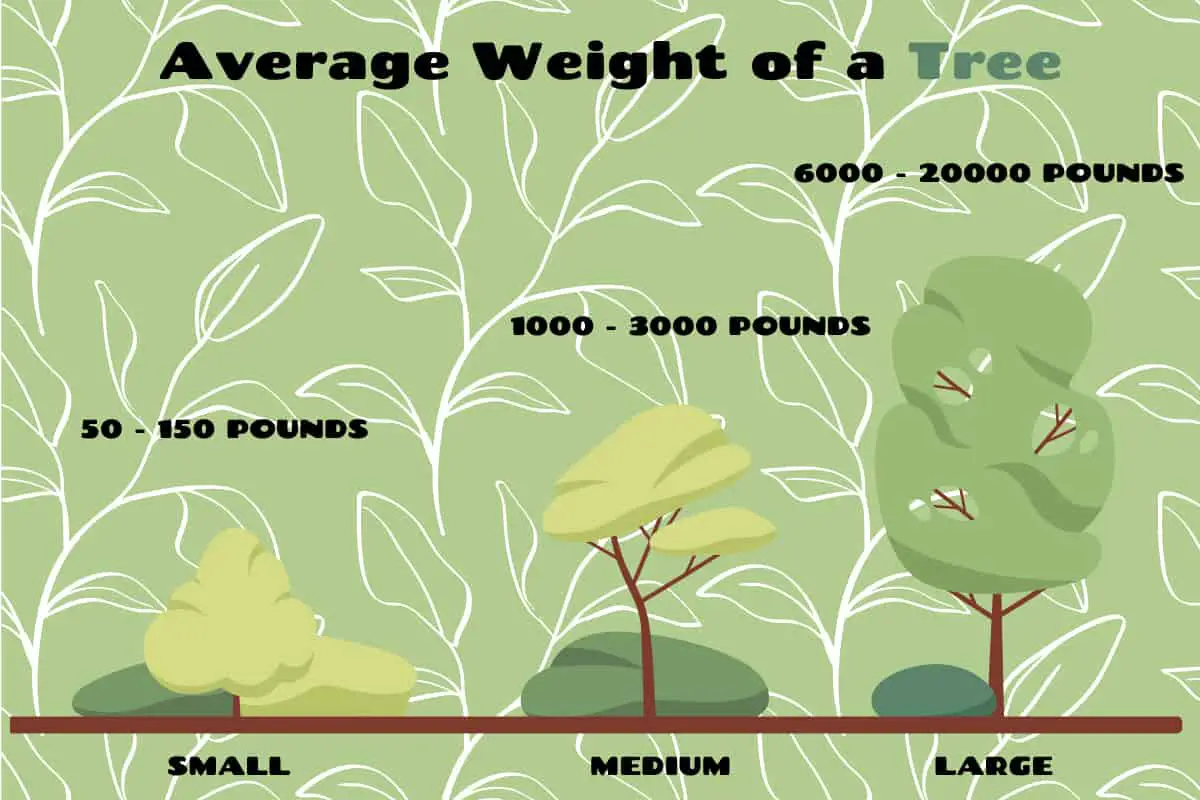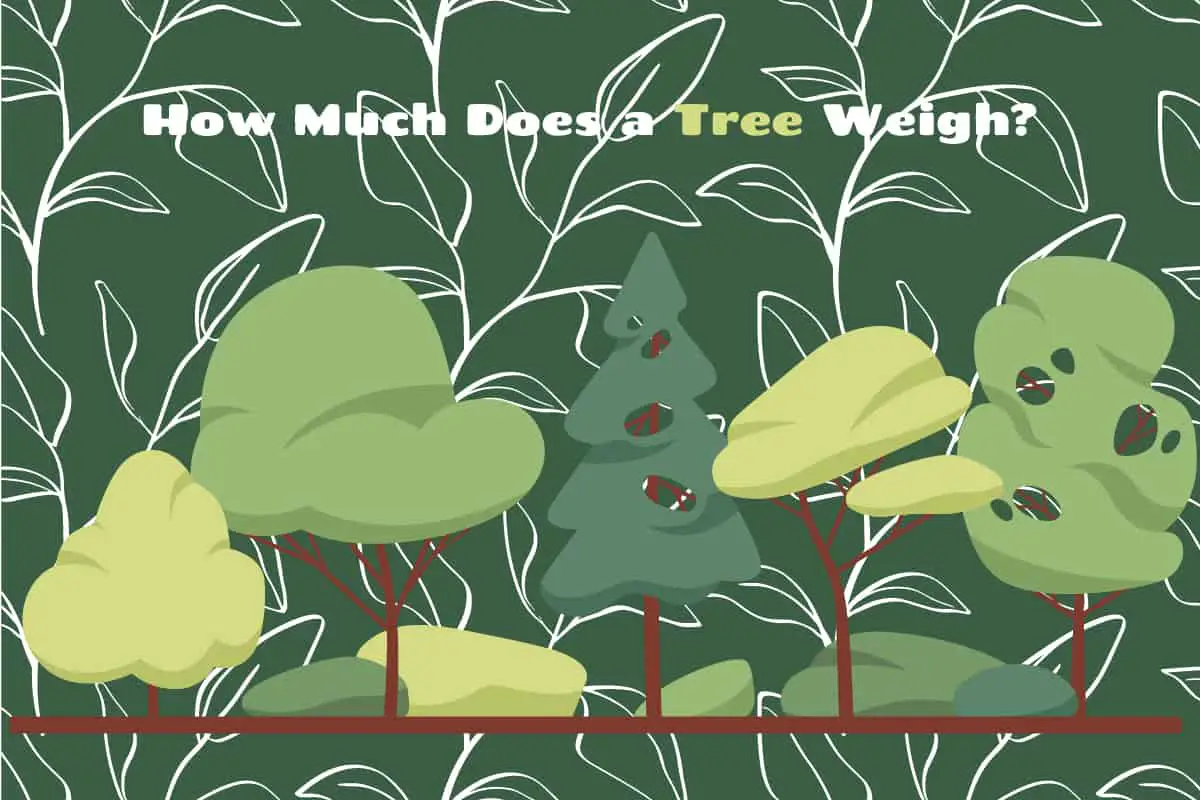Calculating the weight of a living tree is something that has to be done scientifically rather than physically because, of course, it isn’t possible to put a tree on a giant set of scales without first removing it from the ground it is growing in. If you’re intrigued by the weight of trees, there are ways to estimate tree weight based on first finding out a number of factors, including tree height, diameter, and density.
Though there are many variables that will impact the weight of a tree, generally speaking, you can expect a small tree to weigh in the region of 50 to 150 pounds and a medium tree to weigh between 1000 and 3000 pounds. Larger trees will run upwards of 6000 on the scales.
Table of Contents
Average Weight of a Tree

Trees come in a wide range of shapes and sizes, so since there is no average tree size, it is also very difficult to estimate an average tree weight. Lots of different factors will affect the weight of a tree, which further adds to the predicament of concluding the average weight of a tree. For trees that are of medium height, a weight of between 1000 and 3000 pounds would be a fair estimate. When it comes to larger trees, the average weight can range from 6000 to 20,000, with a lot of margin for error.
What Determines Tree Weight
The weight of a tree can vary dramatically depending on a number of different factors, and this can make it really difficult to reasonably estimate tree weight. When considering the approximate weight of a tree, you will need to factor in the following variables.
Trunk diameter
Trunk diameter is a key measurement that is taken when calculating the weight of a tree. The diameter is the measurement from one side of the trunk to the other as if the measuring tool were cutting right through the central part of the trunk. In many trees, the trunk will be broad at the base and begin to taper as it gets taller, which can make taking an accurate diameter measurement quite tricky.
In these cases, it is best to get an average trunk diameter measurement by measuring the trunk at a point where it is neither widest or thinnest. For measuring trees such as this, the diameter measurement should be taken at breast height, which is considered to be 55 inches from the ground.
To calculate a trunks DBH (diameter at breast height), you will need to take a circumference measurement around the trunk at 55 inches from the ground. You can do this by wrapping a tape measure around the outside of the trunk, or if you don’t have a flexible tape measure you can use a piece of string and then measure the piece of string afterward. Once you have the circumference, you can find the diameter by dividing the circumference number by pi.
Height
The height of a tree will, of course, affect the total weight of the tree, though a tall tree is not always going to be the heaviest tree, just as a short tree will not always be the lightest tree. It’s important to consider the height of the tree relative to the trunk diameter.
Density
The density of a tree is going to affect its weight because even if two trees are exactly the same size but one is softwood, and one is hardwood, they are going to have significantly different weight measurements. Hardwood trees produce wood that is much denser and, therefore, much heavier.
Type
The type of tree, in terms of whether it is deciduous or evergreen, can affect the ultimate weight of the tree, depending on when you are taking its measurements. A tree that is evergreen is going to weigh more than a deciduous tree of the same size if you make your calculations when a tree is not in leaf. Although a single leaf may not weigh much at all, when you add potentially thousands of leaves to your weight calculation, they are going to make a significant overall difference.
Species
The species of a tree takes into account a variety of things, including wood density, size, shape, and volume. For example, the Lignum vitae, or ‘Tree of Life’, is known to be one of the hardest and heaviest woods available in the world, with a hardness four times greater than the English Oak (Quercus robur). Even when two trees have identical diameters and heights, the weight of a Lignum vitae is going to far exceed the weight of the other tree.
How to Calculate the Weight of a Tree
The weight of a tree can be calculated by multiplying the volume of the tree by the density of the tree. Both the volume and the density are very tricky to work out correctly, so seeking out the help of a tree expert is going to be the best option in this case. For a rough estimate of how much a tree weighs, you can look at the total height and diameter at breast height, although this calculation will have a wide margin of error.
For trees that have a diameter at breast height measurement of 6 inches, they will weigh approximately 150 pounds at 15 feet in height, 250 pounds at 30 feet in height, 400 pounds at 50 feet in height, and 480 pounds at 65 feet in height.
If your tree has a diameter at breast height measurement of 10 inches, it will weigh around 375 at 15 feet in height, 660 pounds at 30 feet in height, 1000 pounds at 50 feet in height, 1350 pounds at 65 feet in height, 1650 at 80 feet in height, and 2000 pounds at 95 feet in height.
As the diameter measurement gets bigger, the estimated weight of the tree increases significantly. A tree with a diameter at breast height measurement of 16 inches will weigh in the region of 1650 pounds at 30 feet tall, 2670 pounds at 50 feet tall, 3500 pounds at 65 feet tall, 4200 pounds at 80 feet tall, and 5000 pounds at 95 feet tall. A tree with a chunky trunk diameter measurement of 22 inches will be expected to weigh around 8000 pounds at 80 feet in height and 10,000 pounds at 95 feet in height.
Heaviest Trees in the World
The heaviest tree in the world is believed to be an example of a Giant Sequoia (Sequoiadendron giganteum), which is a type of coniferous redwood. The specimen is known as ‘The General Sherman’, and is located in the Sequoia National Park in California, US. The tree has a height of 274.9 feet, and the trunk measures 36.5 feet in diameter at the base and 17.5 feet in diameter at a height of 60 feet from the ground.
It is estimated that this tree weighs an enormous 4.2 million pounds. The second heaviest tree in the world is also a Giant Sequoia, and it is growing in Kings Canyon National Park in California. This tree is known as ‘General Grant’, and stands at 268.1 feet.






